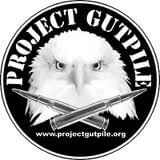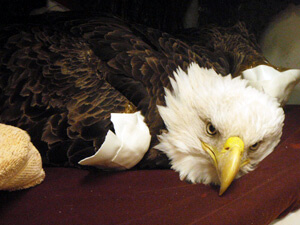National Ban on Lead-based Ammunition, Fishing Tackle Sought to End Wildlife Poisoning – Lead Still a Potent Killer of Millions of Wild Birds, Health Risk for Humans
For Immediate Release Contact:
, 202-234-7181 ext.210
Jeff Miller, Center for Biological Diversity, (510) 499-9185





 |
Adult Bald Eagle unable to stand after lead poisoning. |
WASHINGTON, D.C.— A coalition of conservation, hunting and veterinary groups today filed a formal petition with the Environmental Protection Agency requesting a ban on the use of toxic lead in hunting ammunition and fishing tackle. Major efforts to reduce lead exposure to people have greatly reduced the amount of lead in the environment, but toxic lead is still a widespread killer in the wild, harming bald eagles, trumpeter swans, endangered California condors and other wildlife.
“It's long past time do something about this deadly – and preventable – epidemic of lead poisoning in the wild,” said Jeff Miller of the Center for Biological Diversity. “Over the past several decades we've wisely taken steps to get lead out of our gasoline, paint, water pipes and other sources that are dangerous to people. Now it's time to get the lead out of hunting and fishing sports to save wildlife from needless poisoning.”
An estimated 10 million to 20 million birds and other animals die each year from lead poisoning in the United States. This occurs when animals scavenge on carcasses shot and contaminated with lead bullet fragments, or pick up and eat spent lead-shot pellets or lost fishing weights, mistaking them for food or grit. Some animals die a painful death from lead poisoning while others suffer for years from its debilitating effects.
“The science on this issue is massive in breadth and unimpeachable in its integrity,” said George Fenwick, president of American Bird Conservancy. “Hundreds of peer-reviewed studies show continued lead poisoning of large numbers of birds and other animals, and this petition is a prudent step to safeguard wildlife and reduce unacceptable human health risks.”
American Bird Conservancy, Center for Biological Diversity, Association of Avian Veterinarians, Public Employees for Environmental Responsibility, and the hunters' group Project Gutpile are asking for the ban under the Toxic Substances Control Act, which regulates dangerous chemicals in the United States.
"As a hunter in California, compliance with the recent state nonlead ammunition regulation has been simple," said Anthony Prieto, a hunter and co-founder of Project Gutpile, a hunter's group that provides educational resources for lead-free hunters and anglers. "I still get to hunt, there is no toxic impact on wildlife or my health, and copper bullets shoot better."
The petition references almost 500 scientific studies, most of which have been peer-reviewed, that starkly illustrate the widespread dangers from lead ammunition and fishing tackle. Lead is an extremely toxic substance that is dangerous to people and wildlife even at low levels. Exposure can cause a range of health effects, from acute poisoning and death to long-term problems such as reduced reproduction, inhibition of growth and damage to neurological development. In the United States, 3,000 tons of lead are shot into the environment by hunting every year, another 80,000 tons are released at shooting ranges, and 4,000 tons are lost in ponds and streams as fishing lures and sinkers. At least 75 wild bird species are poisoned by spent lead ammunition, including bald eagles, golden eagles, ravens and endangered California condors. Despite being banned in 1992 for hunting waterfowl, spent lead shotgun pellets continue to be frequently ingested by swans, cranes, ducks, geese, loons and other waterfowl. These birds also consume lead-based fishing tackle lost in lakes and rivers, often with deadly consequences.
Lead ammunition also poses health risks to people. Lead bullets explode and fragment into minute particles in shot game and can spread throughout meat that humans eat. Studies using radiographs show that numerous, imperceptible, dust-sized particles of lead can infect meat up to a foot and a half away from the bullet wound, causing a greater health risk to humans who consume lead-shot game than previously thought. A recent study found that up to 87 percent of cooked game killed by lead ammunition can contain unsafe levels of lead. State health agencies have had to recall venison donated to feed the hungry because of lead contamination from lead bullet fragments. Nearly 10 million hunters, their families and low-income beneficiaries of venison donations may be at risk.
For more information, read about the Center's Get the Lead Out campaign and the ABC web page on lead threats to birds.
Background
Lead has been known to be highly toxic for more than 2,000 years. Its use in water pipes, cosmetics, pottery and food is suspected as a major contributing factor in the collapse of the Roman Empire. Lead causes numerous pathological effects on living organisms, from acute, paralytic poisoning and seizures to subtle, long-term mental impairment, miscarriage, neurological damage, and impotence. Even low levels of lead can impair biological functions. There may be no safe level of lead in the body tissues of fetuses and young. Despite knowledge of how dangerous lead is, it continues to be used in hunting and fishing products that expose wildlife and humans to lead. In recent decades the federal government has implemented regulations to reduce human lead exposure in drinking water, batteries, paint, gasoline, toys, toxic dumps, wheel balancing weights, and shooting ranges.
The California condor, so near extinction in the mid-1980s that the last nine wild birds were captured for an expensive captive-breeding program, had a healthy enough captive population to begin reintroduction into the wild in the mid-1990s. Yet reintroduced condors are far from safe since they feed on carcasses often containing lead bullet fragments. At least 30 condors in California and Arizona have died from lead poisoning since reintroductions began, and chronic, sub-lethal lead poisoning is rampant throughout the four reintroduced condor flocks in the United States. In 2008 California passed the Ridley-Tree Condor Preservation Act requiring use of non-lead bullets for hunting in the condor range. This law has reduced lead exposure, but lead bullets are still available in California and condors, eagles, and other wildlife continue to be poisoned.
Because there are now numerous, commercially available, non-toxic alternatives, the petitioning groups are urging the EPA to develop regulations to require non-lead rifle bullets, shotgun pellets, and fishing weights and lures throughout the nation. Non-toxic steel, copper, and alloy bullets and non-lead fishing tackle are readily available in all 50 states. Hunters and anglers in states and areas that have restrictions or have already banned lead have made successful transitions to hunting with non-toxic bullets and fishing with non-toxic tackle. Over a dozen manufacturers of bullets have designed and now market many varieties of non-lead, nontoxic bullets and shot with satisfactory to superior ballistic characteristics – fully replacing the old lead projectiles. The Toxic Substances Control Act gives the EPA broad authority to regulate chemical substances that present an unreasonable risk of injury to health or the environment, such as lead. The EPA can prohibit the manufacture, processing, and distribution in commerce of lead for shot, bullets, and fishing sinkers.
American Bird Conservancy (www.abcbirds.org) conserves native birds and their habitats throughout the Americas by safeguarding the rarest species, conserving and restoring habitats, and reducing threats while building capacity of the bird conservation movement.
The Center for Biological Diversity (www.biologicaldiversity.org) is a national, nonprofit conservation organization with more than 255,000 members and online activists dedicated to the protection of endangered species and wild places.
Public Employees for Environmental Responsibility is a national nonprofit alliance of local, state and federal scientists, law enforcement officers, land managers and other professionals dedicated to upholding environmental laws and values.
The Association of Avian Veterinarians is an international professional organization of practitioners advancing and promoting avian medicine, stewardship, and conservation through education of its members, the veterinary community and those they serve.
Project Gutpile is a grassroots hunters' organization dedicated to educating hunters and anglers and to saving wildlife from lead poisoning through encouraging the use of nontoxic ammunition.


















































